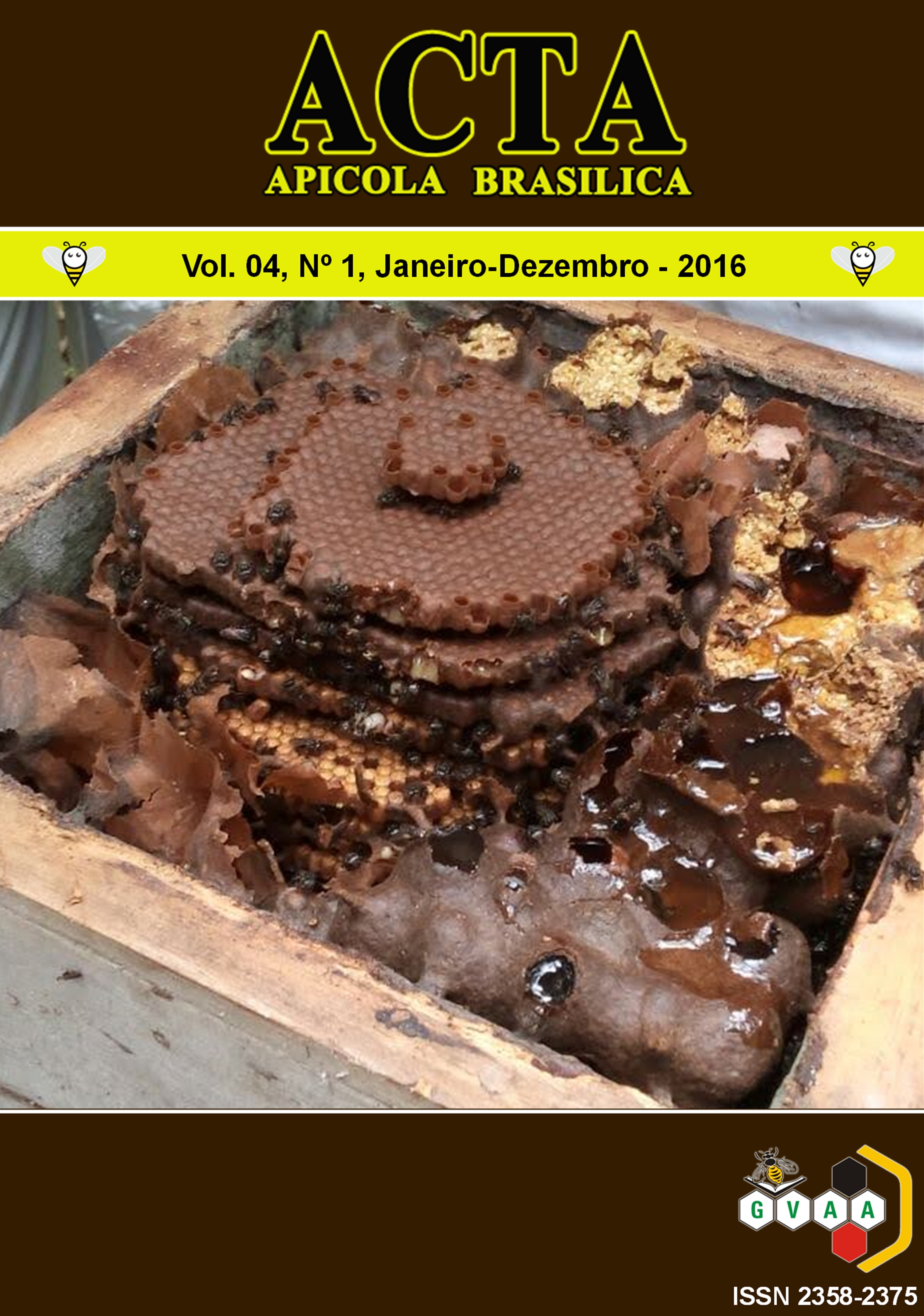Arthropod survey associated with jandaira beehives (Melipona subnitidaDucke) (APIDAE: Meliponinae) at Mossoró-RN, Brazil
DOI:
https://doi.org/10.18378/aab.v4i1.4326Keywords:
jandaira bee, Melipona subnitida, lodgersAbstract
The Jandaira (Melipona subnitida) is an allowed easier handlingbee, it performsa significant role inpollination of native flora. Several insects are listed like tenantsof bee hives, some of them just as commensals, and some harmful. The aim of this study was to identify the arthropod fauna found insidehives of bee Jandaira (M. subnitida) in the region of Mossoró city, RN, Brazil. The study was conducted during Augustand September 2005, in the apiary of stingless bees Monsignor HUBERTO BRUEINING. They were marked on a random basis40 beehives. The captured animals were taken to the Department of Plant Sciences of the Federal Rural University of Semiarid (UFERSA) to be identified. Inquiline was observed in 80% of sampled hives, and 20% of nothing was found. In 45% of observed hives it was found the presence of ants of the genus Crematogaste, Camponotus and Pseudomirmex, and in some cases forming harmful colonies. In 37.5% of the colonies were observed several species of spiders, but it was not possible to identify. In addition to these, they were also found, beetles, termites and moths. It was found that the ants and spiders by the constant presence, constitute important tenants of M. subnitidahives, which entails the recommendation care when performing the management of this bee.
Downloads
References
BARRETO, L. S.; CASTRO, M. S. de. Ecologia de nidificação de abelhas do gênero Partamona (Hymenoptera: Apidae) na caatinga, Milagres, Bahia. Biota Neotropica, v. 7, n. 1, p. 87-92, 2007.
BORROR, D. J.; DELONG, D. M. Introdução ao Estudo dos Insetos. Rio de Janeiro: USAID, 1969.653p.
BRUENING, H. Abelha Jandaíra. Mossoró: Fundação Guimarães Duque. (Coleção Mossoroense), Série “C”, 181p. 1990.
CAMARGO, J. M. F. de.. Notas sobre hábitos de nidificação de Seaura (Seau-ra) /atitarsis (Friese) (Hymenoptera, Apidae, Meliponinae). Bolm Mus. Paraense Emflio Goeldi, Zool., 1(1): 89-95. 1984.
CAMPOS-FARINHA, A. E. de C.; JUSTI JUNIOR, J.; BERGMANN, E. C; ZORZENON, F. J; RODRIGUES NETTO, S. M.; Formigas Urbanas: 2ed., Bol. Téc. Inst.Biol. São Paulo, n.8, p.5-20,set.1997.
CARMO FILHO, F.; ESPÍNOLA SOBRINHO, J. ; AMORIM, A. P. Dados meteorológicos de Mossoró (janeiro de 1898 a dezembro 1987). Mossoró: ESAM/FGD, (Coleção Mossoroense). v.341,325p. 1987.
CONSTATINO, R. Chave ilustrada para dos gêneros de cupins(Insecta:Isoptera )que ocorrem no Brasil. Papéis avulsos de Zoologia, São Paulo 40 (25):387-448,1999.
COLETTO-SILVA, A. Implicações na implantação da meliponicultura e etnobiologia de abelhas sem ferrão em três com unidades indígenas no estado do Amazonas. Tese (Doutorado)-INPA/UFAM, 2005.
GONZAGA,S.R. Criação de abelhas sem ferrão.Cuiabá: SEBRAE,2004,174p.
GONZALEZ, V. H.; MANTILLA, B.; MAHNERT, V.. A new host record for Dasychernes inquilinus (Arachnida, Pseudoscorpiones, Chernetidae), with an overview of pseudoscorpion-bee relationships. Journal of Arachnology, 35(3), 470-474. 2007.
GRECO, M. K.; HOFFMANN, D.; DOLLIN, A.; DUNCAN, M.; SPOONER-HART, R.; NEUMANN, P.. The alternative Pharaoh approach: stingless bees mummify beetle parasites alive. Naturwissenschaften, 97(3), 319-323. 2010.
KALINOVIC, I.; GÜNTHER, K. K.. Fauna Psocoptera Pcelingjaka i Osinjaka (Insecta).(Psocoptera Fauna in Apiaries and Wasp Nests). Znanost i Praksa u Poljoprivredi i Prehrambenoj Tehnologiji, 12(4), 35-42. 1982.
KERR, W. E.; SH. F. SAKAGAMI; R. ZUCCHI; V. DE PORTUGAL-ARAÚJO; J. M. DE CAMARGO. Observações sobre a arquitetura dos ninhos e comportamento de algumas espécies de abelhas sem ferrão das vizinhanças de Manaus, Amazonas (Hymenoptera, Apidae). Acta do Simp. Biota Amazónica, CNPq, Rio de Janeiro, Zool., 5: 255-309. 1967.
LOUREIRO, M. C; QUEIROZ, M. V. B. de. Insetos de viçosa – Fomicidae. Minas Gerais: UFV,105p. 1990.
MARQUES, O. M.; GIL-SANTANA, H. R.; MAGALHÃES, A. C. A.; CARVALHO, A. A. L.. Predação de Apiomerus lanipes (Fabricius, 1803) (Hemiptera: Reduviidae) sobre Apis mellifera (Linnaeus, 1758) (Hymenoptera: Apidae), no Estado da Bahia, Brasil. Entomología y Vectores, 10(3): 419-429. 2003.
NOGUEIRA–NETO, P Vida e criação de abelhas indígenas sem ferrão.São Paulo: Nogueirapis,1997.445p.
OLIVEIRA, T. F. F. N. de.. Um estranho no ninho: A relação entre uma espécie de abelha sem ferrão termitófila obrigatória (Partamona seridoensis) e cupins no semiárido do Rio Grande do Norte. UFERSA (Dissertação), 26p. 2015.
OLIVEIRA, A. P. M.; VENTURIERI, G. C.; CONTRERA, F. A. L.. Body size variation, abundance and control techniques of Pseudohypocera kerteszi, a plague of stingless bee keeping. Bulletin of Insectology, 66(2), 203-208. 2013.
Sharma, N.; Vashisth, S.; Sharma, P. K... Diversity and distribution of pests and predators of honeybees in Himachal Pradesh, India. Indian Journal of Agricultural Research, 47(5), 392-401. 2013.
PEREIRA, F. D. M.; SOUZA, B. D. A.; LOPES, M. D. R.; VIEIRA NETO, J. M.. Manejo de colônias de abelhas-sem-ferrão. Embrapa Meio-Norte-Documentos (INFOTECA-E). 2012.
PERUQUETTI, R. C.. Contribuição ao estudo de Microorganismos e Artrópodes associados às abelhas sem ferrão (Hymeoptera: Apidae). 2000. Disponível em ftp://www.ufv.br/DBG/Apiario/inquilinos.pdf . Acesso em: 29/06/2016.
PERUQUETTI, R. C.; BEZERRA, J. M. D.. Inquilinos de abelhas-sem-ferrão (Hymenoptera: Apidae): aspectos da biologia de Scotocryptus melitophilus Reitter, 1881 (Coleoptera: Leiodidae). Entomotropica, v. 18, n. 3, 2003.
PERUQUETTI, R.; da SILVA, Y. C.; DRUMOND, P.. Forídeos cleptoparasitas de abelhas-sem-ferrão: sazonalidade, distribuição espacial e atratividade de iscas de vinagre. Embrapa Acre-Boletim de Pesquisa e Desenvolvimento (INFOTECA-E). 2012.
SILVESTRI, F.. Contribuzione alla conoscenza dei Termitidi e Termitofili dell’ America Meridionale. Redia, 1:1-235. 1903.
SILVA, R. T. da; CARVALHO-ZILSE, G. A.; RAFAEL; J. A.. Insetos associados a colônias de abelhas sem ferrão amazônicas em meliponário urbano e rural. XX Jornada de Iniciação Científica PIBIC/INPA. Manaus – 2011.
SILVA, A. C. D.; GIL-SANTANA, H. R.. Predation of Apiomerus pilipes (Fabricius)(Hemiptera, Reduviidae, Harpactorinae, Apiomerini) over Meliponinae bees (Hymenoptera, Apidae), in the State of Amazonas, Brazil. Revista Brasileira de Zoologia, 21(4), 769-774. 2004.
VEIGA J. C.; MENEZES C.; VENTURIERI G. C.; CONTRERAF. A. L.. The bigger, the smaller: relationship between body size and food stores in the stingless bee Melipona flavolineata. Apidologie, 44: 324-333. 2013.













